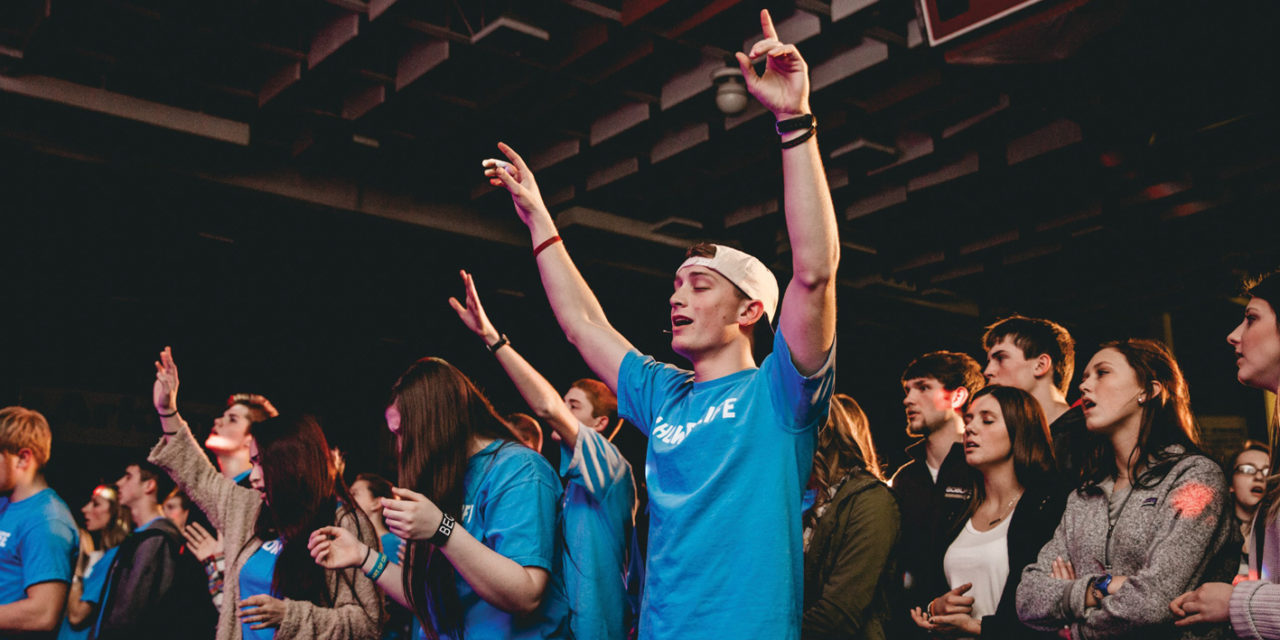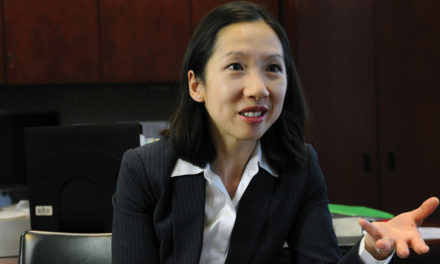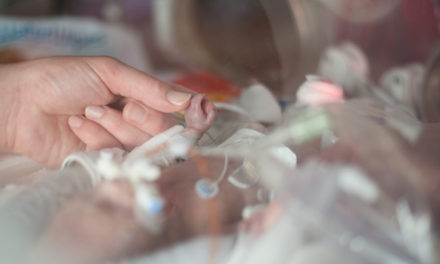Hannah Stephens was 17 and in trouble with her parents. She had gotten caught stealing their tablet computer in order to chat with strangers online and subsequently grounded. “The only places I was allowed to go were home, school and church,” Stephens tells Citizen.
To this brooding teenager in the small Ozark town of Mountain Home, Ark., life seemed painfully limited. Yet she was about to discover a whole new world.
In January 2016, Stephens’s partner in chemistry class at Mountain Home High School Career Academies invited her to join the planning team for an upcoming event for teenagers called HowToLife. The planning process would require her to attend several meetings leading up to a night of worship, testimonies and prayer.
Stephens knew little about the event—only that it had something to do with Christianity. “This counted as a church activity that could get me out of the house and away from my parents,” she recalled.
That was all the incentive she needed. She was in.
“The second I entered that meeting at the First Baptist of Mountain Home youth room, my life was completely changed,” Stephens says, recalling that the students she met seemed to be genuinely in love with God and weren’t merely serving Him out of habit. “I went home that night in tears, telling my mom I wanted what they had, the hope they had.”
That may sound unusual considering Stephens is the daughter of an itinerant church planter, raised in the church and reared in a Christian home. She could recite Bible stories and prayed to accept Christ as a little girl. “I did it because I knew that’s what I was supposed to do,” Stephens remembers. But that was as deep as her relationship with God had gone. She had grown up in a Christian culture but wasn’t yet a Christ-
follower.
For a month leading up to the HowToLife event, however, Stephens felt the Lord working on her heart. She was beginning to really see Who was at the heart of the hope she noticed in her peers. Because her family never settled down in one place, she hadn’t ever connected deeply with Christian young people. Now she felt a dynamic closeness with her new friends. She could see the joy of intimately knowing Christ coloring virtually everything about them.
Though deep down inside she still felt spiritually unprepared, she served as a counselor on the night of the event. “I saw so many hearts change that night, including my own,” Stephens says. “I had friends who started crying and confessing their sins to God, opening up for the first time since I’d known them. It reaffirmed that my generation is utterly heartbroken and needs Jesus.”
A Broken Generation
Demographers, social scientists and journalists commonly refer to Stephens’s generation, starting approximately with people born in the mid- to late-1990s, as Generation Z. Though there seems to be no clear agreement on hard and fast boundary lines, it’s safe to say that anyone who’s a teenager today is part of Generation Z.
This generation has grown up in the digital age, giving it some advantages over prior generations. News outlets have broadly described members of Generation Z as more inherently comfortable with technology and better skilled at multi-tasking than their predecessors.
But there’s a dark side, too. The numbers show Generation Z socializes (at least in person) far less than Generation X or the Baby Boomers. Instead, today’s teens spend large chunks of time checking social media on their phones. A sense of isolation often sets in for Gen Zers, psychologist Jean Twenge wrote in a recent article for The Atlantic, because of factors like cyberbullying and the nagging sense of missing out on the fun everyone else seems to be having. As a result, Gen Zers’ rates of suicide and depression are so high, Twenge fears today’s teens are “on the brink of the worst mental-health crisis in decades.”
That fact hasn’t been lost on Jordan Whitmer.
“[Generation Z is] more broken and more ready than any generation to date to experience Jesus, to have that hope,” the 19-year-old tells Citizen. “So who better than teenagers who do have that hope—who do have Jesus—to be able to step up, to share the Gospel and to reach Generation Z for Jesus?”
Whitmer is the founder and CEO of the HowToLife Movement, the organization responsible for the event that changed Hannah Stephens’s life. It began as an idea in Whitmer’s dining room in December 2014.
Back then, Whitmer was in his junior year at Harrison High School in Harrison, Ark., just across the border from Branson, Mo. He felt a burden for his classmates, so many of whom were spiritually lost. How could he reach them with the Gospel?
The vision that began to take shape in Whitmer’s mind was a student-led youth rally for his whole community. He invited three friends over to brainstorm. There, around the dining room table, they hashed out the details. It would be a night of drama, testimonies, prayer and worship music, all led by students. Though security guards and a few adult chaperones would be there, Whitmer and his fellow organizers decided no one older than 18 would be allowed to take the stage.
The four friends also came up with the unusual name “HowToLife.”
“We were thinking along the lines of how to live your life or talking about how to do life, and the ultimate answer to that is Jesus,” says Whitmer. “So that’s kind of how the name emerged.”
Students and adult leaders at schools and churches across Harrison got involved in spreading the word. When the rally became reality, in March 2015 at a local junior college, 750 students attended—and 75 of them reported placing their trust in Christ for eternal life.
Whitmer was blown away by what God did that night, and he sensed it couldn’t just end there.
A Movement is Born
Word of what happened in Harrison rippled across the Ozarks. Students in other communities wanted to know how they could invite similar work from God where they lived. Whitmer’s instincts were right: HowToLife had become more than just a one-night event in his hometown. It was an emerging movement.
During Whitmer’s senior year, he helped organize HowToLife rallies in Missouri and other parts of Arkansas. HowToLife became an official 501(c)3 nonprofit organization in August 2016. Then, during the 2016-17 school year, communities in Illinois, Tennessee and Texas hosted events.
All told, Whitmer says, there have been 19 HowToLife events in seven states so far. That number is on pace to expand to 15 states by summer vacation, and 20 by the end of 2018. About 600 teens have become Christians at HowToLife rallies so far and gotten connected to local churches.
A Familiar Model
For the moment, Whitmer is HowToLife’s only paid employee, working out of his parents’ home in Harrison. The ministry has 5,000 followers on Instagram, and over the past six months, Whitmer says, hundreds of students have messaged him on social media platforms asking how they can hold HowToLife events in their communities. He responds by assuring them there’s a tried-and-true template to follow.
“It’s in essence like a mini-Billy Graham Crusade event that is done by local high school students to reach their friends and their community for Jesus,” says Whitmer.
Indeed, HowToLife’s event planning model bears many similarities to that of the Billy Graham Evangelistic Association (BGEA). A regional team of students must provide each event’s core leadership. Weeks of detailed preparation (including meetings for prayer and practicing worship music, drama and reciting testimonies) follow. All the while, publicity is spread as students wear #HowToLife T-shirts to school (the social media-friendly hashtag is ever-present in HowToLife’s marketing efforts) and church youth pastors are invited to get involved.
The prayerful preparation pays off the night of each event. At press time, more than 6,000 teenagers had attended HowToLife rallies.
Whitmer readily admits the Graham crusades of the latter half of the 1900s have served as his model. That makes sense given that his grandfather, radio broadcaster and teacher Ron Hutchcraft, has a long history with the Graham, who passed away on Feb. 21 at age 99: Hutchcraft chaired a crusade in New Jersey in the 1990s and has spoken extensively for the organization over the last 30 years.
“I would so love to see a generation of teenagers around the U.S. and around the world that emerge,” Whitmer says. “People that step up, that have a passion for evangelism, a passion for the Great Commission.”
Does all of this potentially make Whitmer his generation’s Billy Graham? Yes and no, he says. Unlike Graham, he doesn’t feel evangelistic preaching is his gift (though he did speak at several HowToLife rallies before he “aged out”). In his desire to build an organization that has global impact, however, Whitmer definitely senses a kinship with the 20th century’s most famous preacher.
“My dream is that ultimately there may be some aspects of true global awakening to Jesus that could come through something like this,” he says.
The Next Phase
From his earliest days, Whitmer has had a sense of where he’s going, and seen no reason to wait in getting there. He led Bible clubs in elementary, middle and high school. After graduating from Harrison High School in 2016 (he was valedictorian), Whitmer sprinted on and completed his bachelor’s degree in Biblical Studies online through Liberty University just a year and a half later.
Now Whitmer is taking on his most exciting, and perhaps daunting, task: Moving HowToLife to the next level.
“I would love to see that we have significantly more paid staff and a headquarters in the next two years, by 2019 or 2020,” Whitmer explains. Getting there, he estimates, will take $500,000. That’s why, in addition to helping regional student leaders organize rallies, he spends much of his time crisscrossing the country on a fundraising blitz.
A survey from the Barna Group released last October revealed that only 4 percent of Generation Z holds a biblical worldview. About 35 percent claim to be atheist, agnostic or unaffiliated with a religion, a figure 5 percent higher than for Generation X and 9 percent more than that of Baby Boomers. Such findings led Barna to describe Gen Zers as the first “post-Christian” generation.
So how does Whitmer explain so many of his peers showing up for HowToLife events, which are overtly Christian?
“People are excited to come out to events that are completely led by their friends because teenagers listen to teenagers more than anyone else,” he says, adding that the teen-to-teen dynamic is “the biggest strength of this movement.”
HowToLife board member Ralf Stores, 63, agrees. “That idea of youth leading youth to Christ has a very powerful component to it,” he says. “I have found over the years there’s almost a universal culture among youth—clothes and talk and music and those sorts of things. It transcends languages and it transcends the different countries and cultures around the world.”
That’s why, going forward, Whitmer says HowToLife will keep the teenagers-reaching-teenagers, no-one-over-18-on-stage component. He believes that inspired idea conceived at his dining room table is timeless.
But he also wants to continue impacting Generation Z as its members enter their 20s and 30s. He’s open to HowToLife becoming a multi-generational, international ministry.
“I believe that God can and will continue to do incredible things through this movement on a teenager level, on an adult level and [through] more and more elements as things continue to grow,” he says.
Whitmer expects to continue leading it for the long haul. Under his leadership, he says not to expect HowToLife to get sidetracked by political debates or to delve deeply into secondary (though still important) moral issues. His plan is to borrow another page from Billy Graham’s playbook and keep the primary focus on the Gospel.
“My firm belief is that the lack of understanding of the Gospel is the root [of Generation Z’s problems]. Everything else stems from that,” he says. “Focusing on Jesus and the Gospel at the center of everything is what I continue to commit to doing.”
For More Information:To learn more about the HowToLife Movement,visit http://howtolifemovement.com
Originally published in the April 2018 issue of Citizen magazine.






